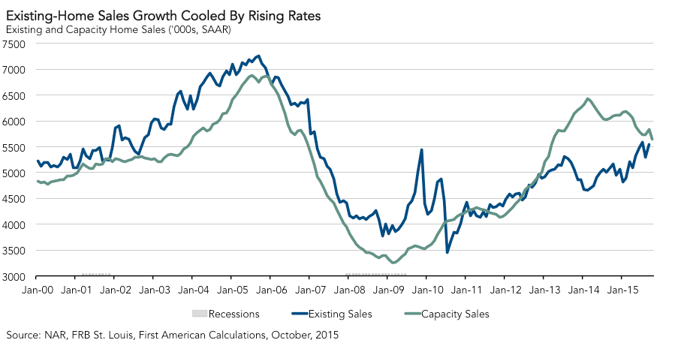For the month of October, First American’s proprietary Existing-Home Sales Capacity (EHS-C) model showed that the market capacity for existing-home sales decreased by 3.1 percent compared to September and decreased by 7.3 percent compared to a year ago. The EHS-C provides a gauge on whether existing-homes sales are under capacity or over capacity based on current market fundamentals. The seasonally adjusted, annualized rate (SAAR) of existing-home sales capacity is up 73.6 percent from the low point of sales reached in February 2009*. The EHS-C decreased by 181,500 sales (SAAR) in October.
EHS-C is down 779,000 sales (SAAR) from the most recent peak in February 2014. The current underperformance gap is an estimated 209,000 (SAAR), which is significantly less than the sales capacity gap of 1.7 million existing-home sales in February 2014.
Analysis: Market capacity pre-adjusting to expected Fed rate increase
The housing market’s capacity for existing-home sales is declining with the expectation of a Fed rate increase pre-adjusting mortgage rates and causing a slowdown in house price appreciation. Market capacity remains modestly in excess of actual sales due to leverage-assisted housing asset inflation, which is home price appreciation fueled by low mortgage rates. Rising mortgage interest rates and moderation in house price appreciation were the most important market fundamentals that reduced market capacity this month. Now that interest rates are pre-adjusting in response to signals from the Fed for a highly expected increase in December, demand is also declining.
“The housing market’s capacity for existing-home sales is declining with the expectation of a Fed rate increase pre-adjusting mortgage rates and causing a slowdown in house price appreciation.”
This past September, I published an analysis of the impact of a possible rate increase on existing-home sales and house prices entitled "Does a Fed Rate Increase Doom Housing?" Based on a 25 basis point increase in the 30-year fixed rate mortgage rate, house price appreciation on a year-over-year basis slows down by 1 percent more than expected without the rate increase. Existing-home sales slow by about 2.5 percent on annualized and seasonally adjusted basis, a decline of less than 150,000 sales a year. The housing market isn’t doomed by a Fed rate increase, but demand would fall modestly.
An increase in rates on the part of the Fed, causing mortgage rates to rise, can actually be good for the housing market in the long run. Continued low mortgage rates are a contributing factor to the pace of price appreciation that we have seen in the housing market over the past three years. Leverage-assisted housing asset inflation is a significant contributing factor to the market capacity for existing-home sales exceeding actual existing-home sales. The longer rates remain, low the longer leverage-assisted housing asset inflation outpaces income growth and reduces affordability for the first-time homebuyer.
Actual existing-home sales were estimated to be 5.55 million (SAAR) in September. Early forecasts for October actual existing-home sales predict a significant drop from the 5.55 million (SAAR) reported in September. Based on our EHS-C model, I estimate that actual existing-home sales in October will be 5.44 million (SAAR).

Looking ahead to 2016, I expect existing-home sales to reach 5.5 million by the end of the year. Housing demand is expected to be increasingly dominated by the first-time homebuyer as existing homeowners will have a reduced incentive to sell in a higher rate environment.
Next EHS-C release: December 17th, 2015 for November EHS-C
*Previous EHS-C releases referred to November 2011 as the low point of sales. The model used to generate existing-home sales capacity has been enhanced to more accurately reflect the dynamic relationships between sales, prices, interest rates and the user-cost of housing, resulting in a model that more accurately reflects past conditions.
About Existing-Home Sales Capacity
First American’s proprietary Existing-Home Sales Capacity (EHS-C) model provides a gauge on whether existing-homes sales are under capacity or over capacity based on current market circumstances. The EHS-C rate provides a measure on whether existing-homes sales, which include single-family homes, townhomes, condominiums and coops, are outperforming or underperforming based on current market fundamentals. The seasonally adjusted annualized EHS-C estimates the historical relationship between existing-home sales and the U.S. population demographic data, income and labor market conditions in the U.S. economy, price trends in the U.S. housing market, and conditions in the financial market. For example, seasonally adjusted, annualized rates of existing-home sales above the level of the EHS-C indicate market turnover is outperforming the rate fundamentally supported by the current conditions. Conversely, seasonally adjusted, annualized rates of existing-home sales below the level of the EHS-C indicate market turnover is underperforming the rate fundamentally supported by the current conditions. Actual seasonally adjusted, annualized existing-home sales may exceed or fall short of the capacity rate of sales for a variety of reasons, including non-traditional market conditions, policy constraints and market participant behavior. Recent EHS-C estimates are subject to revision in order to reflect the most up-to-date information available on the economy, housing market and financial conditions. The EHS-C will be published prior to National Association of Realtors Existing-Home Sales report each month.



